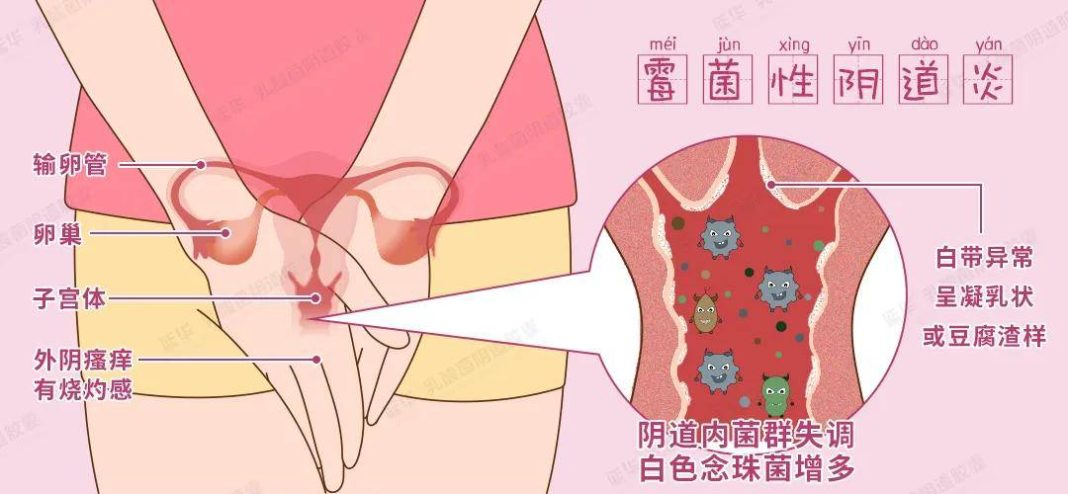According to reports, fungal vaginitis is one of the most common gynecological diseases with a high incidence rate.
Statistics show that at least 75% of women will experience fungal vaginitis at least once in their lifetime, with 40%-50% of women experiencing recurrence, and about 5%-8% of women having 4 or more episodes within a year.
The most obvious symptom of fungal vaginitis is severe itching in the external genitalia, especially worsened at night, accompanied by abnormal vaginal discharge resembling cottage cheese or curd, along with a burning sensation in the external genitalia and vagina, severely affecting the patient’s work and rest.
Why do people get fungal vaginitis?
The culprit of fungal vaginitis is actually Candida albicans, hence fungal vaginitis is also known as candidal vaginitis.
Healthy women have over 200 types of microorganisms in the vagina, with lactobacilli making up 95% and 5% being potentially pathogenic bacteria, such as Candida albicans.
Candida albicans is a “two-sided” organism with two completely different faces – yeast and hyphal phases. In the yeast phase, it does not cause disease, while in the hyphal phase, it can lead to fungal vaginitis. Under normal circumstances, Candida albicans exists in the vagina in the “yeast phase,” coexisting peacefully with other beneficial bacteria present in the vagina without causing diseases. When a woman’s overall or local immunity decreases, there is a reduction in beneficial lactobacilli in the vagina, weakening the ability to resist pathogenic bacteria, and Candida transforms into the “hyphal phase,” leading to the occurrence of fungal vaginitis.
What factors make one susceptible to fungal vaginitis?
1. Infection:
Contact with personal items of individuals with fungal vaginitis, such as bathtubs, towels, etc., or if a sexual partner is infected with Candida, it can easily lead to mutual transmission causing fungal vaginitis.
2. Medications:
Prolonged use of antibiotics suppresses the growth of beneficial lactobacilli in the vagina, causing a microbial imbalance, and the overgrowth of Candida albicans can trigger fungal vaginitis. Additionally, long-term use of estrogen increases vaginal glycogen, acidity, promoting the growth of Candida albicans.
3. Irritants:
The female body’s structure is unique, with the vagina, urethra, and anus converging in one area. This warm and humid environment is conducive to the frequent exchange of microorganisms, making the vagina easily susceptible to fecal contamination. If there is Candida albicans from the gastrointestinal tract in the feces, it can easily contaminate the vagina leading to fungal vaginitis.
4. Pregnancy:
After becoming pregnant, women’s hormonal levels increase, leading to an increase in glycogen content in vaginal epithelial cells, an increase in vaginal acidity, creating an environment conducive to the growth of Candida albicans. Additionally, during pregnancy, the immune system is weakened, making Candida albicans more pathogenic.
5. Wearing tight pants frequently:
Women wearing tight pants for extended periods create a closed, dark, and humid environment around the genital area. In this warm and humid environment, Candida proliferates rapidly, leading to a decrease in the dominance of lactobacilli and causing fungal vaginitis.
6. Diabetes:
Diabetic patients with prolonged high blood sugar levels may experience a weakened immune system and changes in vaginal pH, making it easy for Candida to grow, resulting in fungal vaginitis.
In conclusion, fungal vaginitis is mainly caused by a decrease in lactobacilli and the overgrowth of Candida albicans. In addition to eliminating the source of infection, proper medication and restoration of the normal vaginal microflora are necessary for treating fungal vaginitis. Specific ways to relieve fungal vaginitis will be discussed in the next issue!


